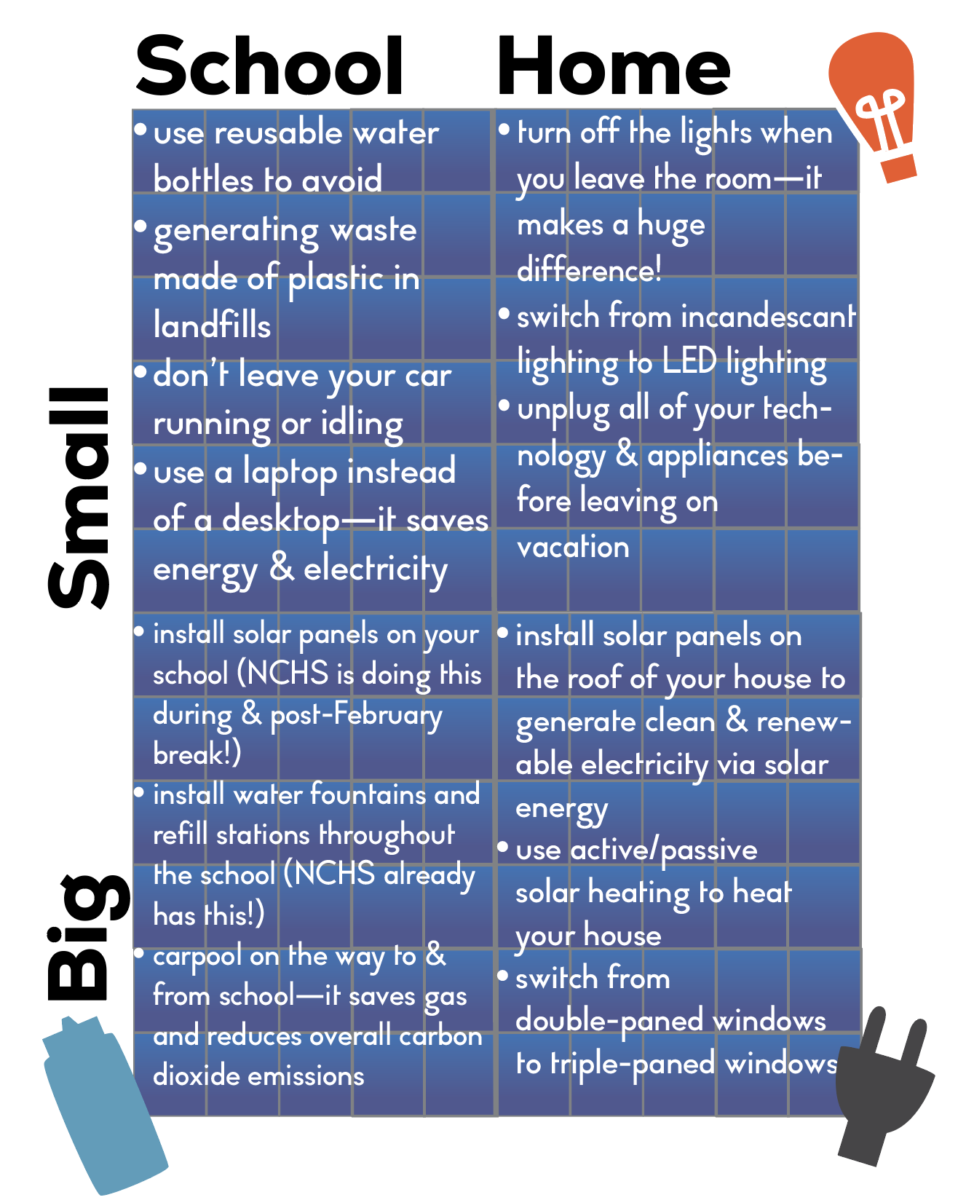Alessandra Gass, Features Editor
@agasscourant
The ongoing threat posed by climate change remains prevalent in the lives of many around the world. In our country alone, forest fires, drought, and hurricanes plague a multitude of flourishing states, however, New Canaan remains sheltered — both physically and metaphorically — from the effects of a changing climate. Despite this, members of the community have begun to implement sustainable alternatives to harmful energy sources and waste-disposal methods that have been in place for decades. Student leadership in regards to environmental consciousness has risen, ultimately benefiting their peers, school, and personal growth. co-founder of Sustainable LFC and a co-president of the Renewable Energy Club
The current state of sustainability at New Canaan schools has been improved throughout the past few years. “NCHS is a very environmentally conscious school, as students and staff understand the importance of mitigating our contributions to climate change and this is reflected in the investments we’ve made into making our school a more sustainable building,” said Trifan Macintire, co-founder of Sustainable LFC and a co-president of the Renewable Energy Club. “We are very fortunate to have the resources available to make sustainability a reality at our school and with student and faculty leaders in place who care about making this community a better place.”
In the past, an emphasis was placed on smaller ways to save energy, like. “A few years ago, parents brought in the recycling bins to try and get to more single-stream recycling,” said Principal Bill Egan. “This was one of the first official steps toward becoming more environmentally conscious, and though small, it was a move in the right direction.”
However, recycling isn’t always a reliable option when attempting to offset a substantial carbon footprint. “We have been more successful with paper recycling than we have been with plastic and glass, but unfortunately, there has not been a consistent effort to maintain either,” said Assistant Principal Ari Rothman. “There used to be a carding company that picked up the garbage and didn’t separate the trash, undoing all of our work. If we want change, we needed to take control of our actions and not rely on corporations.”
Junior Luke Huang, the founder of the Renewable Energy Club and co-founder of Sustainable Lower Fairfield County (SLFC) has taken great interest in protecting the environment, and plans to do so by cutting the school’s emissions. “The Renewable Energy Club has measured the carbon footprint of the school based on their utility, heating, and electricity bills, and plans to create a climate-neutral NCPS by creating and implementing a step-by-step plan,” he said.
“The aim of becoming the first carbon neutral school in Connecticut in compliance with the United Nations’ Climate Neutral Now initiative, we believe that a future of carbon neutrality at NCHS is very near, requiring just a few more actions to be taken to mitigate our current emissions.”
Trifan
Such action can also be seen on a global scale, and Luke plans on using that to his advantage.“There is a UN organization called the United Nations Framework Convention on Climate Change (UNFCCC). One of its programs is called ‘Climate Neutral Now’ and it’s a plan for building climate neutral schools,” said Luke. “We plan to meet with the district and hopefully administer some of these guidelines in schools district-wide.”
Though administrators aim to achieve lower carbon emissions, budgetary restrictions make ideal action difficult. “Our focus is to be as environmentally conscious as possible while not spending too much money,” said Mr. Rothman. “For example, the buses went to propane versus being diesel. Not only does this save money, but they run much cleaner, since a bus used to run in the morning and emit fumes around the school, but now our local environment is cleaner due to the switch.”
Another example of lower-level action that yields an inexpensive cost is the switch to light emitting diode (LED) lights. “If you look around in all the classrooms, there are now LED lights that can be dimmed to certain degrees,” said Mr. Egan. “It saves money and is more efficient for the school. That’s something that was done this year, and was also done in every school in the district.”
Newer projects initiated district-wide have begun to culminate, many of which being initiated by administrators and faculty members. “Our school is now getting into solar energy, but a few other NCPS schools have already installed solar panels,” said Mr. Egan. “From the auxiliary gym to the guidance suite, solar panels will be installed on the roof, with construction beginning just after February break. With everything combined, there is a big reduction of cost for the district and benefit for the environment.”
Additionally, student-initiative is a factor to climate neutrality. “We want students to be very involved in this process, so we want to play into what makes the student body feel inclined to support the offsetting of their emissions at the school,” said Luke. “Reducing emissions at our school is very dependent on student action, so if a student has a suggestion, we will absolutely listen and consider implementing it or adding it to our plan.”
Mr. Egan suggests that students begin with smaller action to contribute to a larger goal. “We need to start with simple and more attainable action, like bringing a water bottle and refilling them rather than buying plastic ones. It’s also equally as important to simply be aware of how to help the environment in school and at home,” he said.
Though the term ‘recycling’ is often thrown around in conversations regarding sustainability, it is a great step in the right direction when done correctly. “Telling kids to recycle is redundant, but really impactful when done correctly, so take a few extra seconds to put paper in the correct pin and separate your plastics,” said Mr. Rothman. “Additionally, begin to truly clean up after yourself. The more work the custodians have to do, the more water is wasted, and more cleaners have to be used, which poses a threat to our local environment and it’s inhabitants.”
Trifan agrees that student action plays a significant role in achieving a school with lower emission. “While fairly basic, these actions are fundamental components to increasing sustainability. When these actions are translated on to a scale of 1200 students, the amount of waste reduced or plastic saved from landfills truly is big enough to make an impact in the fight against climate change,” he said. “While the responsibility of students in this effort may not seem important compared to the authority held by school officials in making NCPS buildings more environmentally friendly, everyone must buy into this initiative for everything to fall into place.
Luke’s goal for the school has both long term and short term results, but depend s on the willingness of the district and the motivation of students. “In the short term, which is about 3 or 4 months, we expect that we can definitely get the school to become climate neutral,” he said. “Our long term goal is to make our school carbon zero. This will take a lot of reform, and though it will take multiple years, I’m confident that administrators and students alike are capable of improving our environment significantly.”




